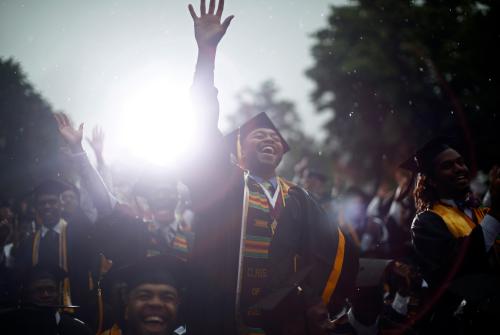EXECUTIVE SUMMARY
The facts are clear: a college education strongly affects whether Americans can make the climb up the income ladder. Data covering the last four decades show that adults who have degrees from two-year or four-year colleges have far higher family incomes than do adults who have only a high school degree or are high school dropouts. Further, income has grown steadily over time for those with college degrees while remaining stagnant or declining for those with a high school education or less. Previous Economic Mobility Project findings showed that adult children from poor and low-income families who earn a college degree are much more likely to move up the income ladder past peers in their own generation than are those without a degree. Adult children from families in the bottom fifth of the income distribution, for example, are four times as likely to reach the top fifth if they achieve a four-year college degree.
Despite the evidence that poor and low-income children benefit enormously when they attain a college education, they are nonetheless less likely to enroll in either two- or four-year colleges, and less likely to complete a degree once they have enrolled. Although the difference in degree completion can be attributed, in part, to lower levels of academic preparation, even those poor and low-income children with the same level of preparation are significantly less likely to attend and complete college than are their higher-income peers. A body of evidence suggests this is partly because the costs of college attendance put greater pressure on the limited resources of poor families, and partly because these students lack information about colleges and student aid as well as social and scholarly supports while attending college.
Thus, improving the equality of educational opportunity—a traditional American value—is one key to promoting economic mobility for disadvantaged students. The federal government has long been involved in promoting postsecondary education, especially since the enactment of the G.I. Bill near the end of World War II. The federal arsenal to promote educational opportunity includes grants, loans, and tax breaks. In the 2007–2008 school year, all levels of government and the private sector spent an impressive $162.5 billion on student aid, much of it based on need and amajority of the support provided by the federal government. However, current expenditures on postsecondary education are not as effective as they could be, nor are they necessarily targeted at those studentsmost in need of support. To promote equality of educational and economic mobility, this report offers recommendations to increase the college enrollment and graduation rates of poor and low-income students. Our recommendations include the following:
Improve Students’ K-12 Achievement and Preparation
- Increase the quality and coverage of preschool programs for poor children
- Establish a culture of college-going in schools
- Improve academic preparation for college coursework
- Build longitudinal data systems in states to track academic progress from preschool through college
Provide Students with Effective Guidance in Selecting and Paying for College
- Improve college and financial aid counseling in high schools
- Simplify the application for federal aid and provide early notification to families
- Reform the Pell grant by providing the maximum benefit to families under 150 percent of poverty and increasing the maximum grant to over $5,000
- Terminate several redundant federal grant programs
- Provide stipends for older students
- Expand the Income-Based Repayment system
- Reform state financing of postsecondary education by providing 25 percent of basic support to colleges and universities in the form of vouchers for low-income students; create a $500 million federal pot to match state voucher programs
Help Students Persevere in College and Achieve a Degree
- Provide federal incentive grants encouraging colleges and universities to mount innovative programs to help disadvantaged students stay in college
Clarify the Goals of Federal Policy and Research
- Make college enrollment and graduation rates of students from low-income families a top priority of federal education policy and research










